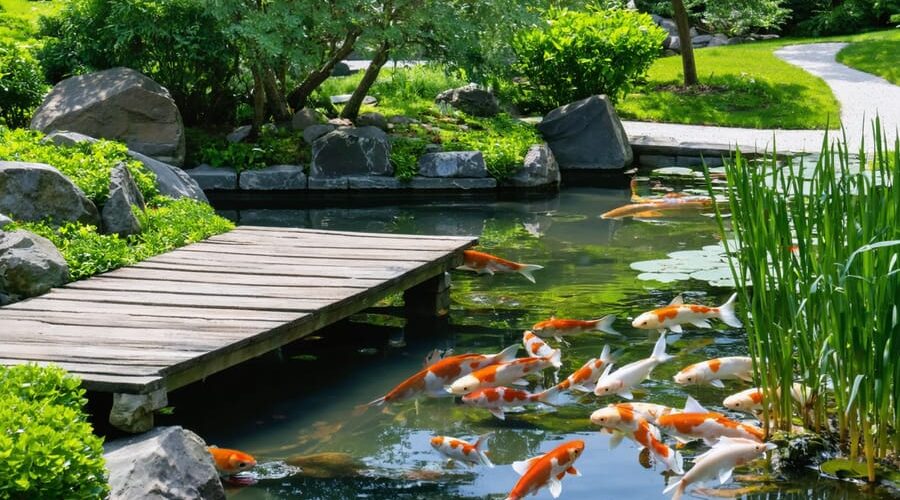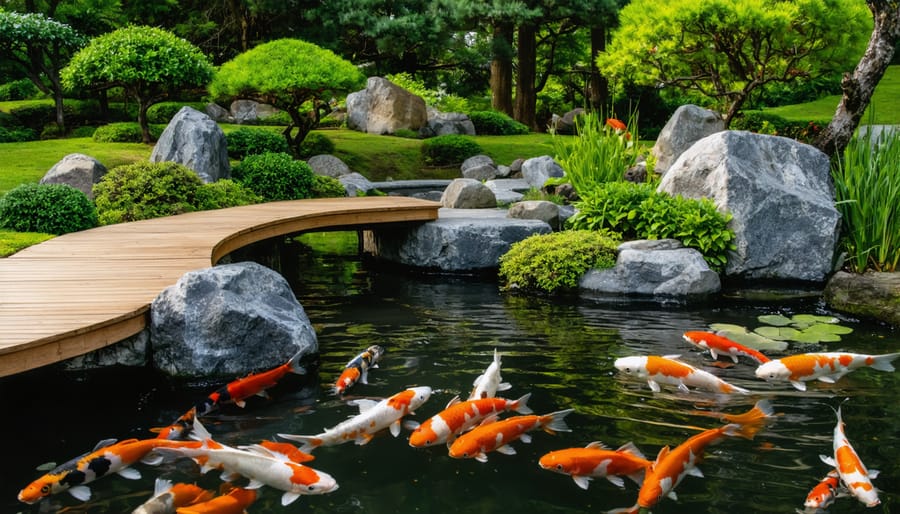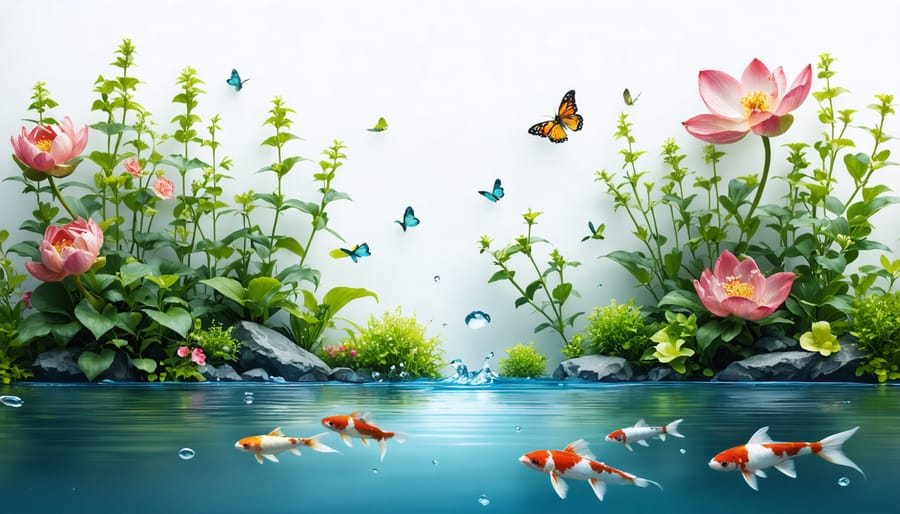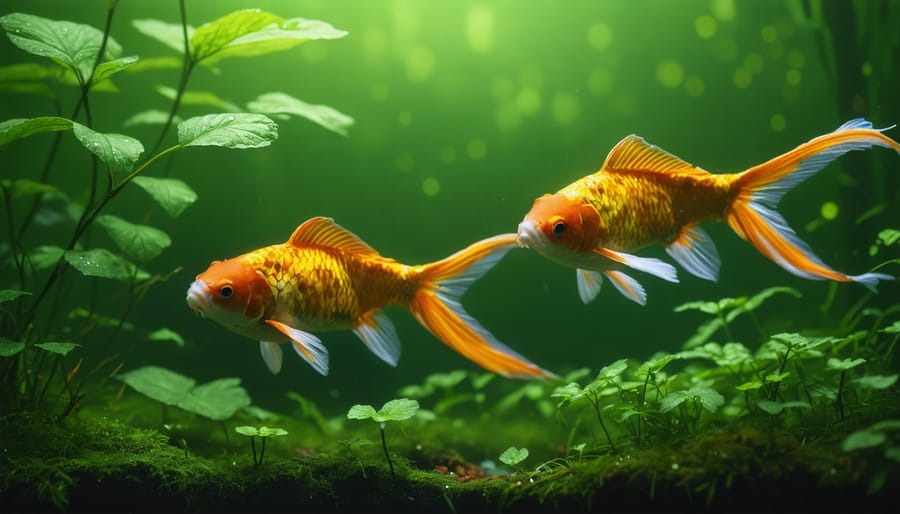
Transform Your Backyard Into a Living Canvas: Water Gardens with Koi
Transform your backyard into a living masterpiece by combining the serene beauty of water gardens with the mesmerizing grace of koi fish. These aquatic sanctuaries offer more than just visual appeal – they create a harmonious ecosystem where colorful fish glide beneath floating water lilies and gentle fountains provide a soothing soundtrack to outdoor living. Whether you’re a seasoned pond enthusiast or just beginning your water gardening journey, the marriage of carefully selected aquatic plants and elegant koi creates an enchanting display that evolves with each season.
A well-designed water garden with koi serves as both a stunning focal point and a dynamic habitat, where every element plays a crucial role in maintaining balance. The interplay between fish and foliage not only delights the senses but also establishes a self-sustaining environment that supports the health of both plants and animals. From the shimmering scales of Japanese koi to the delicate blooms of floating plants, each component contributes to a living tapestry that brings traditional Asian garden aesthetics into modern landscapes.
In this guide, discover how to create and maintain your own slice of aquatic paradise, where the art of water gardening meets the joy of koi keeping.
Creating the Perfect Canvas: Designing Your Water Garden

Balance and Movement
Creating a harmonious water garden is like composing a beautiful painting, where every element plays a crucial role in the overall composition. Whether you’re designing a Japanese-style water garden or a contemporary oasis, balance is key to achieving visual appeal.
Start by dividing your pond into thirds both horizontally and vertically. This “rule of thirds” helps create natural focal points where elements like waterfalls or statement plants can be positioned. Allow roughly 60% of the water surface to remain open for koi movement and viewing pleasure, while dedicating 40% to plant zones and features.
When placing water features, consider the natural flow of movement. Position waterfalls or fountains where they’ll draw the eye through the garden, creating a journey for viewers to follow. Arrange plants in graduating heights, with tall marginals at the back and shorter floating plants toward the front.
For koi comfort and visual interest, include both deep and shallow areas. Deep zones provide safety for fish, while shallow shelves accommodate marginal plants. Create gentle curves rather than sharp angles in your design – this mimics nature and helps establish a more relaxing atmosphere.
Remember to balance hardscape elements like rocks and softscape features like plants. Use odd numbers of groupings, as they tend to look more natural and pleasing to the eye. This thoughtful arrangement ensures your water garden becomes a living masterpiece that’s both beautiful and functional.
Depth and Dimensions
When designing your water garden for koi, proper depth and dimensions are among the most essential koi pond elements to consider. For healthy koi development, your pond should be at least 4 feet deep, with 5-6 feet being ideal. This depth provides protection from predators and extreme temperatures while giving your fish plenty of room to grow and thrive.
The surface area of your pond matters just as much as its depth. Plan for at least 50 square feet of surface area, though larger is always better when it comes to koi. A good rule of thumb is to allow 250 gallons of water per adult koi, which translates to roughly 10 square feet of surface area per fish.
Shape your pond with both function and beauty in mind. Include varying depths with shelves and ledges for aquatic plants, creating a natural-looking transition from shallow margins to deeper areas. These different zones not only add visual interest but also provide important environmental variety for your pond ecosystem.
Remember to incorporate gently sloping sides rather than vertical walls. This design choice helps prevent erosion, makes maintenance easier, and creates a more natural appearance. It also allows wildlife to enter and exit safely if they accidentally fall in.
Living Colors: Selecting and Arranging Aquatic Plants
Surface Plants and Floating Gardens
Floating plants add an enchanting dimension to your water garden, creating a natural, layered look that koi absolutely love. Water lilies are the stars of any pond, with their spectacular blooms in pink, white, yellow, or purple floating gracefully on the surface. Their large pads also provide essential shade for your koi and help control algae growth.
For smaller spaces, water hyacinths create lovely purple spikes of flowers while their trailing roots help filter the water. Lotus plants add drama with their tall stems and magnificent flowers that rise above the water’s surface. Their seed pods even add winter interest to your pond.
Don’t overlook duckweed and fairy moss – these tiny floating plants create a carpet-like effect and provide additional filtration. They also offer hiding spots for baby fish and help reduce water temperature on hot days. For best results, combine different types of floating plants to create visual interest at various heights and provide multiple benefits for your koi habitat.
Remember to maintain a good balance – aim to cover about 60% of your pond’s surface with plants to maintain healthy water conditions while leaving plenty of open swimming space for your koi.

Marginal and Submerged Plants
Marginal and submerged plants add essential layers to your water garden, creating a natural ecosystem that benefits both your koi and the overall aesthetic. Marginal plants, which grow along the pond’s edges in shallow water, include beautiful specimens like iris, rushes, and marsh marigolds. These plants not only provide visual interest but also help stabilize the pond’s edges and offer shelter for small aquatic life.
Submerged plants, growing entirely underwater, are your pond’s natural filters. Popular choices like hornwort and anacharis help maintain water clarity and provide oxygen, making them perfect companions for your koi. When placing these plants, arrange them at different depths to create a dynamic underwater landscape.
For the best results, plant marginals in dedicated baskets filled with aquatic soil, positioning them on shelves or ledges around your pond’s perimeter. Submerged plants can be weighted and anchored to the bottom or planted in deeper baskets. Remember to maintain a balance – aim for about 60% plant coverage to keep your pond healthy while still giving your koi plenty of swimming space.
Plant and Koi Compatibility
When selecting plants for your koi pond, it’s essential to choose varieties that can coexist harmoniously with these active fish. Koi are naturally curious and may nibble on or uproot certain plants, so opt for sturdy specimens with strong root systems. Water lilies make excellent companions, as their large leaves provide shade and protection for koi while being robust enough to withstand some investigation from the fish.
Floating plants like water hyacinth and duckweed can work well but may need regular maintenance as koi might snack on them. For marginal plants, consider iris, rush, and cattails, which have strong roots that can withstand koi activity. Place these in shallow shelves or containers along the pond’s edge where they’re less likely to be disturbed.
Submerged plants like anacharis and hornwort are great for water quality but should be planted in weighted containers or protected areas. Avoid delicate floating plants or those with fragile stems that can’t withstand the movement of large koi. Remember that young plants are more vulnerable, so it’s best to establish them before introducing koi or protect them with rocks until they’re well-rooted.

Koi as Living Art
Color Patterns and Varieties
Koi fish are living works of art, known for their stunning array of colors and patterns that can transform any water garden into a mesmerizing display. The most common variety is the Kohaku, featuring a white base with red patterns, often considered the classic koi pattern. The Sanke adds black markings to the white and red combination, while the Showa reverses this with a black base decorated with red and white.
For those seeking something different, the metallic-scaled Ogon koi comes in solid gold or platinum colors that shimmer beautifully under sunlight. The Butterfly koi, with their long, flowing fins, add an extra element of grace to your pond, though some purists consider them less traditional.
Each koi’s pattern is unique, like a fingerprint, and can change slightly as the fish grows. When selecting koi for your water garden, consider how their colors will complement your water plants and surrounding landscape. Dark-colored koi show up better in deeper ponds, while bright varieties create stunning contrasts against water lilies and floating plants.
To best appreciate your koi’s colors, maintain clear water and include viewing areas where you can observe them from above and at eye level. Remember that healthy koi display more vibrant colors, so proper care directly affects their visual appeal.
Creating Visual Drama
Creating visual drama in your water garden starts with thoughtful design elements that highlight your beautiful koi. Strategic placement of rocks and plants can create natural viewing areas where your fish naturally gather. Consider adding shallow shelves or peninsulas that extend into deeper water, creating perfect spots for observing your finned friends.
To showcase your koi with lighting, install underwater LEDs in areas where fish tend to congregate. This creates stunning nighttime displays and makes it easier to enjoy your pond after dark. Position lights near water features or beneath floating plants to create enchanting shadows and reflections.
Color contrast plays a vital role in making your koi stand out. Choose darker bottom materials like blue or black liner, which create a perfect backdrop for viewing bright-colored fish. Add stepping stones or a viewing bridge to create different perspectives and vantage points. These elements not only add visual interest but also provide practical viewing spots.
Consider installing a raised viewing window or clear acrylic panel in one section of your pond. This allows you to observe your koi from a unique underwater perspective and adds an exciting architectural element to your water garden. Remember to keep some areas of the pond open and free from plants, creating designated swimming zones where your koi can become the stars of the show.
Maintaining the Beauty
Seasonal Care
Your water garden requires different care throughout the year to maintain its beauty and health. In spring, remove debris that accumulated over winter and trim dead foliage from aquatic plants. This is also the perfect time to divide and repot overgrown water plants and prepare your garden for the growing season.
Summer brings lush growth and vibrant blooms, but also increased algae risk. Regular maintenance includes removing fallen leaves, deadheading spent flowers, and managing aquatic plant growth. Keep water levels consistent during hot weather and ensure your pond has adequate shade to protect koi from intense sunlight.
As autumn approaches, install pond netting to catch falling leaves before they sink and decompose. Gradually reduce feeding as temperatures drop, and begin removing tropical plants or preparing them for indoor winter storage.
Winter care focuses on maintaining a small opening in the ice for gas exchange if your pond freezes. Use a pond heater or aerator rather than breaking the ice, which can stress koi. Remove snow from the pond’s surface to allow light penetration for any underwater plants, and avoid disturbing your koi during their winter dormancy.
Remember that seasonal transitions should be gradual to help your koi adjust comfortably to temperature changes.
Water Clarity and Health
Clear water is essential for both the health of your koi and the visual appeal of your water garden. Maintaining crystal clear water requires a balanced approach combining proper filtration, regular maintenance, and careful plant selection.
A well-designed filtration system should include mechanical and biological components. The mechanical filter removes debris and particles, while biological filtration helps break down harmful waste products. Adding beneficial bacteria regularly helps establish and maintain this biological balance.
Plants play a crucial role in water clarity by absorbing excess nutrients that could otherwise feed algae. Water lilies, in particular, provide shade that helps control algae growth while creating natural hiding spots for your koi. Floating plants like water lettuce and submerged plants such as hornwort are excellent natural filters.
Monitor water parameters weekly, including pH, ammonia, and nitrate levels. Keep fallen leaves and debris out of the pond using nets during autumn, and perform partial water changes monthly. A UV clarifier can help control single-celled algae, but shouldn’t be relied upon as the sole solution.
Remember that crystal-clear water isn’t always the healthiest – a slight green tint is natural and can actually benefit your ecosystem. Focus on maintaining balance rather than pursuing perfectly clear water at all costs.
Creating and maintaining a water garden with koi is truly a living work of art that evolves and grows more beautiful with each passing season. As your plants mature and your koi develop their stunning colors and personalities, you’ll find yourself drawn to spend more time by the water’s edge, finding peace in the gentle sounds of flowing water and joy in watching your fish gracefully glide beneath lily pads.
The journey of building and nurturing your water garden brings rewards that go far beyond mere aesthetics. You’ll discover a deep connection with nature as you witness the delicate balance between plants, fish, and water quality. Each challenge you overcome, from achieving crystal-clear water to maintaining healthy plant growth, adds to your expertise and satisfaction as a water gardener.
Perhaps most rewarding is the way a water garden becomes a gathering place for family and friends, creating memories around this living landscape. Whether you’re feeding your koi with children, hosting garden parties, or simply enjoying a quiet moment of reflection, your water garden provides a unique sanctuary in your outdoor space.
Remember that every water garden is unique, reflecting its creator’s vision and style. As you continue to learn and experiment, your garden will evolve into an even more beautiful and harmonious ecosystem. The time and effort you invest in your water garden will be returned many times over in the joy and tranquility it brings to your daily life.
